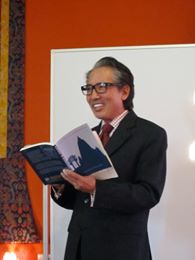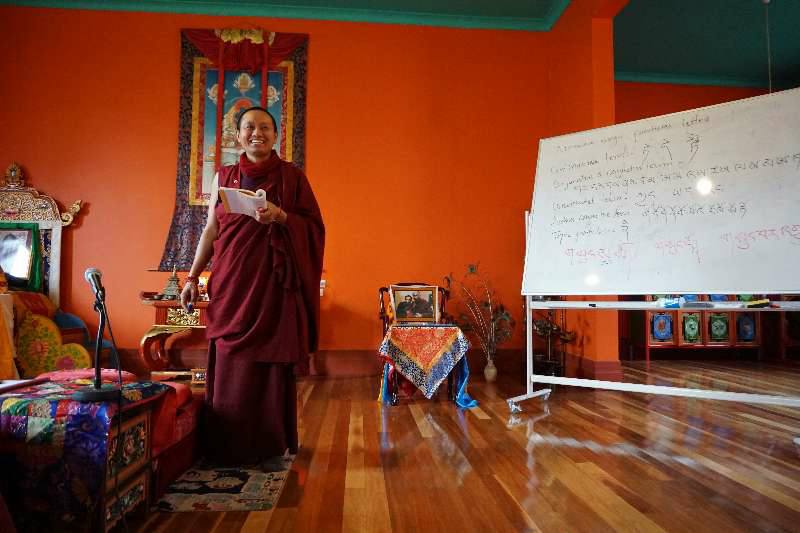
A Journey Through Shedra
The Venerable Traleg Rinpoche kindly offered to teach the Shedra to his younger students beginning in 2010. Shedra (the Tibetan word for ‘place of learning’) is the traditional education taught in Tibetan Buddhist nunneries and monasteries. In hindsight, it was such a good way for newcomers to the Centre to develop a solid grounding in traditional Buddhist education. It should be said that there is nothing in the Shedra that Rinpoche has not already taught us since arriving in Australia in 1980. The more one reads and listens to Rinpoche’s older teachings, you realise how the Shedra content is constantly being brought up again and again.
Rinpoche started his students with the text Gateway to Knowledge by Mipham Rinpoche (1846-1912), a renowned Nyingma meditation master and scholar. Mipham Rinpoche also had a close connection with the Kaygu lineage, having been given a retreat hut at Thrangu Monastery in Tibet in which to practise and write. This auspicious sense of lineage and connection was yet another blessing Rinpoche was able to provide his students as he took us through the Mipham Rinpoche texts.
There was such a joy every time Rinpoche walked into the Gompa. We were all receiving an incredible direct transmission of the Shedra. How lucky and fortunate. Attending a teaching from Rinpoche was more than receiving the Dharma words – you were inspired by the person delivering the message. The mind of an awakened being. The joy, and lightness of being, were so infectious and somewhat intoxicating. The more we studied and learned our Sanskrit, the happier Rinpoche was. He told us how he took such pleasure in our learning of the Dharma.
Rinpoche began the Shedra by teaching on the Five Skandha’s, which provide an idea of our personhood. As Rinpoche has taught many times, we are not of a fixed identity. There is no inherent ‘I’, or soul, that makes up who we are. Rather, as the Five Skandha’s explain, we have many facets that make up our being.
Other topics studied included Dependent Origination (the 12 links). This explains how our very life and all phenomena come about – that everything is produced based on the interdependence of their respective causes and conditions. Another topic covered a breakdown of our faculties and our senses. How do they operate? Not just the anatomical eye organ for example, but is there a consciousness or power behind this organ? And what is the contact that is made between the object and the sense faculty?
Rinpoche was able to take his students through volume one of Gateway to Knowledge before his Parinirvana in 2012. Dealing with this immeasurable tragedy, filled with grief and loss, The Venerable Thrangu Rinpoche kindly sent Khenpo Chonyi Rangdrol to continue the teachings Rinpoche had set out for us. Again, the students were so blessed to receive the transmission from Khenpo-la, who is such a kind, caring, and humble teacher. The students have grown to love and care for Khenpo-la very much. We have all taken delight in staffing and preparing meals for Khenpo-la. He has always made so much time for Rinpoche’s students, answering all our questions and taking us through volumes two, three and four of Gateway to Knowledge.
Through these texts, we have studied many topics such as the Four Noble Truths, Hinayana and Mahayana paths, Buddha Nature and the Four Seals of the Dharma.

We are now studying Gampopa’s Jewel Ornament of Liberation. Our most recent set of classes in 2019 focused on the Six Paramitas. Studying such profound teachings not only trains your mind, but these teachings serve as a constant reminder of how to conduct yourself. The Six Paramitas are difficult to practice. It is much easier to over-eat and watch Game of Thrones than it is to exercise patience and vigour and sit on the cushion. The final teaching for 2019 dealt with the sixth paramita of Wisdom – learning to understand that all phenomena are by nature empty, unborn and without roots.
Khenpo-la is a truly incredible scholar, with an excellent command of English. We were therefore able to receive teachings effortlessly under his guidance. Khenpo-la was also inspirational in his behaviour and conduct. Whenever I entered his room to greet or serve, Khenpo-la was either practicing, saying mantras, or studying. He is so kind to all of the students. We all have no doubt Traleg Rinpoche would be happy that Khenpo-la is teaching us. And we are all most grateful to the Venerable Thrangu Rinpoche for sending Khenpo-la to us to oversee our Shedra education.
Written by Matthew H
